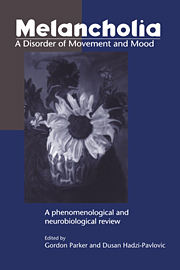Book contents
- Frontmatter
- Contents
- List of contributors
- Acknowledgments
- Introduction
- Part One Classification and Research: Historical and Theoretical Aspects
- Part Two Development and Validation of a Measure of Psychomotor Retardation as a Marker of Melancholia
- Part Three The Neurobiology of Melancholia
- 15 Melancholia as a Neurological Disorder
- 16 Melancholia and the Ageing Brain
- 17 Magnetic Resonance Imaging in Primary and Secondary Depression
- 18 Functional Neuroimaging in Affective Disorders
- 19 Summary and Conclusions
- The CORE Measure: Procedural Recommendations and Rating Guidelines
- References
- Author Index
- Subject Index
17 - Magnetic Resonance Imaging in Primary and Secondary Depression
from Part Three - The Neurobiology of Melancholia
Published online by Cambridge University Press: 04 August 2010
- Frontmatter
- Contents
- List of contributors
- Acknowledgments
- Introduction
- Part One Classification and Research: Historical and Theoretical Aspects
- Part Two Development and Validation of a Measure of Psychomotor Retardation as a Marker of Melancholia
- Part Three The Neurobiology of Melancholia
- 15 Melancholia as a Neurological Disorder
- 16 Melancholia and the Ageing Brain
- 17 Magnetic Resonance Imaging in Primary and Secondary Depression
- 18 Functional Neuroimaging in Affective Disorders
- 19 Summary and Conclusions
- The CORE Measure: Procedural Recommendations and Rating Guidelines
- References
- Author Index
- Subject Index
Summary
Structural Imaging in Neuropsychiatry
Given the capacity of magnetic resonance imaging (MRI) for
(i) precise visual presentation of neuroanatomical structures;
(ii) differentiation of grey and white matter structures;
(iii) detection of white matter lesions;
(iv) reconstruction of images in multiple planes; and
(v) the utilisation of differing scan sequences to highlight varying tissue characteristics
it is well suited for investigating brain structure in patients with neuropsychiatric disorders (Andreasen 1988; Krishnan 1993b). Additionally, as it does not involve ionizing radiation, repeated examinations are possible. This is of key importance in unravelling diagnostic issues in psychiatry. Specifically, for those interested in the relationships between the affective and degenerative disorders of late life, the combination of MRI and longitudinal clinical methodologies is essential.
For patients presenting with psychomotor change, cognitive dysfunction and/or psychotic features, MRI provides ready visualisation of the limbic system and other key basal ganglia structures which have been proposed as providing critical neuroanatomical pathways (Krishnan 1991; Krishnan 1993b; Drevets et al. 1992; Cummings 1993; Mayberg 1993). As MRI technologies are increasingly integrated with other functional scanning systems (positron emission tomography [PET] and/or single photon emission computed tomography [SPECT]), the co-registration of data provides the capacity to describe precisely the anatomical regions exhibiting differences in regional cerebral blood flow (rCBF) or ligand binding in neuropharmacological and neurochemical receptor studies.
Relationships between neuroanatomical lesions and their consequent local, and broader regional, biochemical effects can now be directly explored.
Information
- Type
- Chapter
- Information
- Melancholia: A Disorder of Movement and MoodA Phenomenological and Neurobiological Review, pp. 252 - 266Publisher: Cambridge University PressPrint publication year: 1996
Accessibility standard: Unknown
Why this information is here
This section outlines the accessibility features of this content - including support for screen readers, full keyboard navigation and high-contrast display options. This may not be relevant for you.Accessibility Information
- 2
- Cited by
